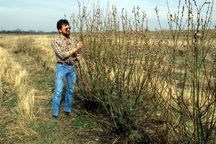 Purdue News
Purdue News
 Purdue News
Purdue News
April 1997

|
The result can be too much plant growth, such as the cattails and other plants choking the Everglades. In some cases algae and other microscopic plants multiply rapidly, die and decompose, robbing the water of oxygen and eventually killing fish.
So farmers plant bands of grasses, shrubs and trees between farm fields and rivers, creeks and ditches. But while the strips slow erosion and trap the nutrients that rain washes out of the fields, they're money out of the pockets of farmers who make their living planting grain.
Purdue wildlife specialist Brian Miller, agronomist Keith Johnson and horticulturist Bruno Moser are researching various shrubs to help offset the cost to farmers and provide valuable animal habitat and erosion control at the same time.
Starting in 1990, the scientists planted pussy willow, red twigged dogwood and corkscrew willow as part of a filter strip along a farm field. The plantings need little or no attention during the regular cropping season, provide good wildlife habitat, and the branches can be harvested for sale to florists.
The shrubs they planted along a creek have done an excellent job of trapping soil as well as taking up the fertilizer that runs off the field.
"You can tell the strip's taking up the nutrients from the runoff," Moser says. "There is a visible difference in size between the row closest to the field and the one farthest from it."
According to Miller, the thick, bushy shrubs also provide a haven for wildlife to feed, nest and hide from predators and bad weather. Often, these small patches of habitat are all the shelter they have.
"In an intensively cropped area like we have in most of northern Indiana, about the only place wildlife has to live is in these marginal areas along ditches, windbreaks and farmstead shelterbelts," Miller says. "They need a place they can get out of the severe winter weather."
The bushes also trapped and held corn stubble and soil that normally would have washed into a ditch and moved on to clog culverts and drain tiles.
Both scientists say the other benefit of the filter-strip shrubs are their potential to pay back the farmer who plants them. The shrubs were chosen specifically because florists use the branches in floral arrangements. Moser says an enterprising farmer can harvest the twigs during the winter and make money selling them to local florists or a wholesaler.
"The numbers look so good I'm almost scared to tell anybody," says Moser, who worries that too many producers would swamp local florists.
The researchers' economic breakdown from the third-year harvest suggests that a farmer could earn $5,000 per acre from a strip planted with 660 shrubs per acre. That's more than enough to make taking the land out of row crop production worthwhile, Moser says.
But he warns that it's a different kind of farming, where marketing skills mean more than having a green thumb. Still, on a limited scale, Moser says he thinks the shrubs provide the economic reward to allow farmers to implement the environmental practice.
"It would be a nice complement to land signed up as buffer areas for the Conservation Reserve Program," Moser says of the federal program that pays farmers to take farm land out of production for environmental benefits. While the program probably would not allow farmers to harvest shrubs on land it's paying for, Moser thinks the shrubs could be planted next to the CRP filter strips. Under the CRP, land can be placed in filter strips, riparian buffers, field windbreaks, grassed waterways or shallow areas for wildlife.
"Farmers could split it up, put 80 percent into CRP and 20 percent into the horticultural shrubs," Moser says.
He and staff members from Purdue's Department of Horticulture also have been experimenting with long-term storage of pussy willows, and artificially forcing the twigs to bloom out of season. He says he thinks florists would want a year-round supply of willows and, if the scientists are successful, it would expand the market for the branches.
Sources: Brian Miller (765) 494- 3586; e-mail, Brian_Miller@acn.purdue.edu
Bruno Moser (765) 494-1352
Writer: Chris Sigurdson (765) 494-8415; e-mail, sig@ecn.purdue.edu
Purdue News Service: (765) 494-2096; e-mail, purduenews@purdue.edu
Photo Caption
Purdue wildlife specialist Brian Miller inspects the branches on filter-strip bushes
that farmers could harvest and sell to florists. (Purdue Agricultural Communications
Photo by Bruno Moser)
Color photo, electronic transmission, and Web and ftp download available. Photo ID:
Moser/Shrubs
Download here.